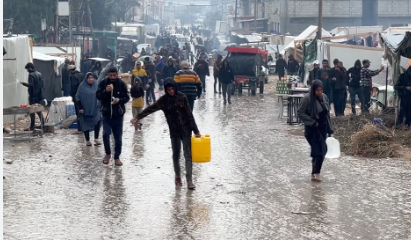New York (Web Desk): The humanitarian crisis in Gaza has reached alarming levels, with nearly a million people at risk of facing a harsh winter without proper shelter. As temperatures continue to drop, the United Nations (UN) has warned that the necessary winter aid is insufficient to meet the growing needs of the population.
The ongoing Israeli airstrikes and bombardments have left widespread destruction across the Gaza Strip, particularly in the northern regions, where hospitals and schools have been severely damaged.
Kamal Adwan Hospital in North Gaza is reported to be in appalling condition, struggling to cope with an overwhelming number of casualties, while dozens of schools have been hit since early October, disrupting education for thousands of children.
Flooding earlier this winter has only worsened the situation, further damaging makeshift shelters that many displaced families have been forced to build.
Humanitarian teams have managed to assist some 285,000 people with repairs to these shelters, but there are still more than 900,000 people who urgently need protection from the elements.
Over 58,000 sealing-off kits and 36,000 tarpaulins, which were procured to provide shelter for about 400,000 people, remain stuck at the border due to the limited flow of aid trucks into Gaza, where only 10 trucks are allowed to enter each week.
On top of these logistical challenges, aid convoys inside Gaza are facing violent attacks. In mid-December, a convoy of 70 trucks entering through the Kerem Shalom crossing was raided by looters, resulting in the loss of nearly all its supplies. On the same day, another convoy was targeted by gunfire as it departed from the Kissufim crossing.
These incidents highlight the extreme insecurity that aid workers face when trying to deliver essential supplies to those in need.
The ongoing Israeli military operations in Gaza have also blocked vital aid from reaching certain areas, especially in the north. Despite numerous attempts to deliver aid to towns like Beit Lahiya and Beit Hanoun, these efforts have been stalled for over two months.
Humanitarian agencies have reported that out of 339 planned aid missions between 1 and 16 December, nearly half were either denied or obstructed by the Israeli authorities, further complicating relief efforts.
The public health situation in Gaza is rapidly deteriorating. There has been a sharp increase in respiratory illnesses, diarrhoea, and other waterborne diseases, with more than 1.2 million cases of respiratory infections and over half a million cases of diarrhoea reported in 2024 alone.
Children, already among the most vulnerable, are suffering disproportionately, and health officials warn that the onset of winter will only exacerbate these conditions.
Many displaced families are trying to survive by building makeshift homes from the rubble of destroyed buildings in areas like Khan Younis and Ma’an. These fragile shelters are at high risk of collapse, especially with the approaching rains. The lack of sturdy housing and essential supplies has left many people exposed to the harsh elements, while the threat of disease continues to loom large over the population.
Meanwhile, the ongoing violence has claimed countless lives. In just the last week, 273 Palestinians were killed, and 853 more were wounded. Since the start of the conflict in October 2023, the Palestinian death toll has surpassed 45,000, with tens of thousands more injured.
On the Israeli side, at least 1,500 people, including civilians and soldiers, have died in the conflict, and nearly 2,500 have been injured.
The blockade of northern Gaza continues, preventing any substantial aid from reaching some of the most devastated areas, while humanitarian operations in the south are severely hampered by the escalating violence.
Despite international appeals, there has been little progress in securing a steady flow of aid to those most in need. The scale of destruction and the lack of access to vital supplies have pushed Gaza’s population into an even more desperate situation.
For many, survival this winter will depend on the ability of international agencies to overcome the logistical and security barriers preventing aid from reaching those in urgent need.
But with temperatures plummeting, time is running out. Without immediate and sustained relief, the situation could worsen even further, claiming even more lives and leaving an already suffering population in an even more perilous position.


